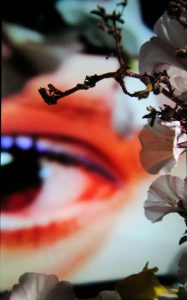
“Eye and Morning Glories II” by Jury S. Judge
Smartphone in Osaka
Dave Gregory
A sleek black Fujitsu smartphone rests face down on a wooden bench beneath a blooming cherry tree. On the same bench, a red-headed woman grips her purple Samsung and types with hyperactive thumbs.
A blond man asks, “After we’ve toured Osaka Castle, can you help me select a birthday card?”
“Just grab any card.” She doesn’t look up from her device. “Your dad won’t know what it says.”
“But your Japanese is better. I might accidentally buy a ‘Sorry for your Loss’ card.”
“For heaven’s sake, just make sure there’s a cake and balloons on it.”
Most photos on the Fujitsu have been transferred from previous devices. The oldest image, taken a decade ago, portrays the couple kissing in a log cabin. A fireplace blazes. Red-and-green wrapping paper lies crumpled in front of the blond man.
The woman is often the sole subject: sitting on a tree swing at sunset; framed in an arched, stone doorway; lounging across a heart-shaped pile of yellow leaves. A smaller, circular image of the same woman reading a leather-bound journal appears above the name Belinda,
followed by endless text messages to the phone’s owner, whom she addresses as either Sweetie, Darling, or—lately—Dawson.
In another early photo, Belinda’s hair is tied in pigtails. She stands center-stage in a tiny theatre, under bright lights, wearing a hooded red cape. Other snapshots show her in different costumes. The newer the picture, the larger the theatre—and the farther she drifts upstage. One- and two-year-old photos of the couple in New York don’t show her on any stage at all.
“It’s not failure. It’s a career change,” he’d texted after she booked their flight to Japan.
He grips the bench with both hands and glances sideways. “You can’t spend five minutes to help me buy a card, though I’ve supported you from Smith’s Falls to Kingston, then Toronto, New York, and now Osaka?”
“This again. You can do design work anywhere. Japan is the only place where I can” —she makes air quotes with her fingers, still clutching her phone— “‘Teach English in Japan.’ I have lessons to plan, assignments to grade. I don’t know why I thought I could spare the time to play tourist with you today.”
“It just seems silly that we’ve been here six months without seeing the castle—or anything.”
When the couple appears together in photos stored on the phone, they always look happy—shopping at outdoor farmer’s markets, holding hands on wilderness trails, laughing beneath bright umbrellas—but those pictures dwindle in number each year.
In the most recent image, only minutes old, her lips form a straight line. She stands under a blossom-covered cherry tree with the green, white, and gold, pagoda-style castle towering in the background. A scowling portrait, taken seconds before this one, has already been deleted.
“Explore the castle if you want. I’ll wait by the gate.” Belinda rises and departs. Her feet
pound heavily despite her slight frame. After ten steps, she glances toward a spot two steps behind her. She double-takes and glares at Dawson, who is still on the bench. Her eyes narrow. She marches onward, chin held high.
He whispers, “Fuck it,” stands, and walks toward the castle. The phone, which stores thousands of design ideas, presentation notes, and business contacts, remains on the bench.
A short, gray-haired local man in a jacket and tie finds the abandoned Fujitsu half a minute later. He presses the main button, and the smiling faces of a red-headed woman and a blond man appear on the lock screen. He turns and looks in every direction, squinting.
The Japanese man hurries toward the castle and intercepts Dawson near the entrance. He holds the phone beside the man’s face, nods, and presents the device.
Curious, Dawson stares at the illuminated phone. His eyes shift to the Japanese man, then back. “How’d you get that picture?”
Dawson reaches for his back pocket, taps it twice, then pats all his pockets. His jaw falls open, he shudders, holds a hand to his chest, and breathes deep. He accepts the phone and says, “Arigato, arigato, arigato.”
The Japanese man bows, and Dawson does the same.
“I don’t know how else to thank you.”
He stands beside his new friend, leans closer, and holds the device at a distance. The camera clicks. He glances at the new portrait of the two smiling men, displays it, then presses the device against his heart and slowly nods.
Inside the castle, phone clutched in both hands, Dawson rides the elevator to the top floor for panoramic views of the fortress—a green and pink oasis amidst a dingy city of concrete and glass cluttered with warehouses.
Far below, a distant woman waits at the gate. He snaps a photo, then stretches the image with his thumbs until red hair and a purple smartphone become visible. Belinda is still riveted to her screen. Dawson takes another peek through the window. Her back has turned, and she’s exiting the gate.
He rolls his eyes, shakes his head, and releases a tiny laugh. He taps his phone and replaces his lock screen image with the picture of himself and the kind Japanese stranger, then continues touring the castle.
Dave Gregory is a Canadian writer, a retired sailor, and an associate editor with the Los Angeles-based Exposition Review. Please follow him on Twitter @CourtlandAvenue.
